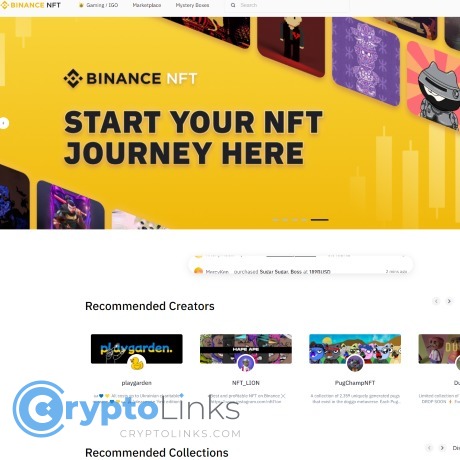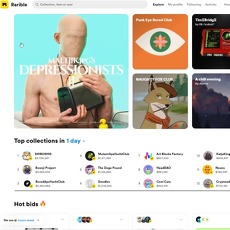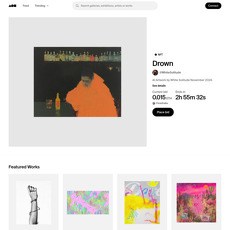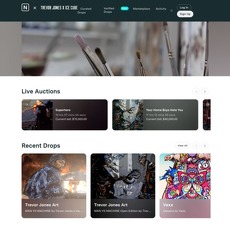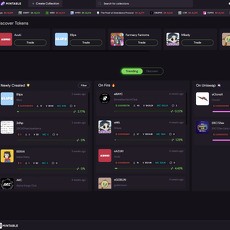Binance NFT Review
Binance NFT
www.binance.com
Binance NFT Review Guide: Is It Worth Your Time and Money? (Everything You Need To Know!)
Have you wondered if Binance NFT is actually worth your attention and hard-earned cash—or is it all just hype from excited crypto enthusiasts? Can you really make $100 a day flipping NFTs, or is this too good to be true?
If you're new to NFTs or simply haven't spent much time exploring Binance NFT specifically, I totally understand—it can feel overwhelming. There's no shortage of platforms to buy and sell digital collectibles, but choosing the right one is crucial if you want things to go smoothly. The truth is, picking a platform randomly or choosing based solely on popularity can lead to frustration, wasted money, and ultimately missing out on genuine opportunities to earn profits.
Why Choosing the Right NFT Platform Matters
Believe me, the platform you choose makes a massive difference. I've spoken with dozens of new NFT traders who got frustrated or discouraged just because of issues related to complicated platforms, hidden fees, slow transactions, or even difficulty reselling NFTs.
Here are some of the potential pain points you might encounter if you select the wrong NFT marketplace:
- High and unexpected fees: Some NFT platforms charge hidden fees that cut heavily into your profits, especially if you're flipping NFTs regularly.
- Lack of trading volume: Picking a platform with low activity or limited interest can make reselling your investments tricky and unprofitable.
- Poor user-friendliness: NFT trading is complicated enough already, so encountering confusing navigation or unclear processes only adds to your headaches.
- Unclear security: Trusting your precious money and assets to a loosely secured marketplace is obviously risky. You don't want to wake up losing your NFTs due to poor platform security.
I’ll Show You Exactly What Binance NFT Has to Offer
Don't stress—I got you covered. I've spent considerable time thoroughly testing Binance NFT, and I'm going to simplify everything it offers. From its basic features to the potential ways of making decent side-income from this platform, I've researched everything thoroughly. My goal is simple: to save you countless hours of searching random forums or shady websites, giving you everything clear and simple, in one convenient and easy-to-understand guide.
How You'll Benefit From This Guide
In this detailed Binance NFT review guide, I promise to:
- Clearly explain how Binance NFT marketplace really works—buying, selling, minting, and exploring.
- Show you various realistic ways to genuinely make money, setting truthful expectations, and dispelling common myths.
- Address your burning questions and doubts, ensuring you know exactly what Binance NFT can (and cannot) deliver.
I know firsthand how overwhelming NFTs can feel when you're new or considering a new platform. I'm here to simplify things and help you steer clear of costly mistakes. But before we jump into specifics, let's first answer an essential question clearly and honestly: What exactly is Binance NFT, and how does it really work day-to-day?
What Exactly Is Binance NFT and How Does It Work?
If you're stepping into NFTs for the first time or you've heard about Binance NFT but don't exactly know what the big fuss is, I completely understand. When I first heard about NFTs, I was skeptical too, asking myself: "Does anyone really pay for digital art or collectibles?" Turns out, millions of people do!
"NFTs aren't just digital pictures—they represent real ownership and value in the digital age, making them powerful tools for artists, investors, and everyday crypto fans."
But what exactly is Binance NFT, and how can it fit into your crypto journey? Let me quickly and easily explain this for you.
Understanding NFTs: A Quick Refresher
Just so we're on the same page, NFTs—or Non-Fungible Tokens—are unique digital assets stored on a blockchain. Think of them like one-of-a-kind collectible cards or limited-edition sneakers—only digital! Because they're unique, NFTs come with built-in scarcity, and their value often depends on rarity, popularity, or even the fame of their creators.
NFTs aren't just for art; their uses extend far beyond! For instance:
- Digital Art and Collectibles: Artists sell unique images, GIFs, videos, or music tracks as NFTs, creating authentic digital ownership.
- Gaming Assets: NFTs can represent in-game items you genuinely own and can trade or sell, rather than just borrowing within a game.
- Real-world ownership: Even physical assets like real estate, luxury watches, or event tickets can be represented by NFTs.
This digital ownership revolution isn't a fad; a recent DappRadar report estimates that NFT sales volume reached over $24 billion in 2022 alone. Clearly, there's real passion, genuine value, and big opportunity in the NFT space!
Binance NFT Marketplace Overview
Okay, so now, what's special about Binance NFT specifically? Binance NFT is an easy-to-use marketplace built directly into the famous Binance crypto exchange. Binance created this space because it understood people need a simpler, secure, and trustworthy way to trade NFTs without technical headaches.
Here’s a quick peek at what you can do on Binance NFT:
- Buy NFTs: From digital art and collectibles, gaming items, or event tickets—you'll find lots to purchase and potentially profit from.
- Sell NFTs: Got something valuable? Quickly list it on the marketplace and set your own price or auction.
- Mint NFTs (Create your own): Yes! If you're artistic or creative, you can mint your own NFTs easily, without getting lost in complicated blockchain transactions.
- Browse Trending Collections: Easy-to-navigate categories and personalized recommendations help you spot what's hot.
- Check Users and Community: Follow your favorite artists, fans, or influential NFT collectors, and see their profiles and activities clearly displayed.
The best thing? You don’t even need dedicated blockchain knowledge; Binance provides simplified tools that any beginner can master quickly.
Mystery Boxes on Binance NFT
Ready for a little excitement? Mystery Boxes are Binance NFT's hugely popular feature. These fun, lottery-style NFT packs give you random collectibles, some of which can turn into highly valuable finds!
It works like this:
- You buy a Mystery Box, not knowing exactly what's inside.
- You open your box to discover one or more NFTs—some common, some rare, or, if you're lucky, ultra-rare and profitable.
Imagine the feeling of opening a Mystery Box and suddenly holding the digital equivalent of a valuable rookie baseball card—it happens more often than you’d think!
Mystery Boxes are thrilling and are often your entry point into deeper NFT trading or investing, making Binance NFT marketplace relatable and fun.
Now, you might wonder: "Can NFTs really make serious money, say, $100 a day?" Stick with me—I'm going to uncover the truth about how realistically profitable Binance NFT can be in the next section. Want to know what's possible?
Making Money With Binance NFT - What's Realistic?
We all see flashy headlines claiming easy cash from NFTs, but what's really behind the excitement? Let's cut through the noise: can you honestly expect to make substantial money using Binance NFT, or is it just hype and wishful thinking? I've closely followed user experiences and conducted my own experiments to unpack the real opportunities available. Here’s a truthful, practical look at what you can expect when trying to earn from Binance NFTs.
"Investing should be more like watching paint dry or watching grass grow. If you want excitement, take $800 and go to Las Vegas." - Paul Samuelson
Flipping NFTs for Profit
Flipping NFTs simply means buying low and selling higher, hopefully generating a tidy profit. This can be lucrative, but you need to know what's hot and understand market trends. Realistically:
- Profits vary significantly—some flips yield 2–3 times your investment, while others barely break even.
- Timing is vital; always check trending collections under Binance NFT's 'Hot Collections' section before buying.
- Following your gut won't cut it—research carefully. Tools like Binance's historical sales data are key to predicting profitable flips.
For example, a recent Binance NFT collection tie-in with popular artist Jimmy Choo sold out almost instantly, leading smart traders who bought early to realize instant profits of over 50%. On the other hand, blindly jumping into an unknown collection or fad NFT can easily result in losses. Always analyze clearly before committing.
Creating and Selling Your Own NFTs
If you're creative, crafting your own NFT art can definitely pay off, but it also comes with risks:
- Be honest: NFT collectors appreciate authentic creativity—generic NFT designs rarely succeed.
- Build your followers first through social media or community engagement, as loyal fanbases significantly boost NFT collection performance.
- Consider your minting fees when pricing your artwork. The lower the initial cost, the easier it becomes to remain profitable.
An excellent example is ‘CryptoSharks’, a cute, creatively-driven NFT collection that built a passionate community on Twitter before launching on Binance NFT, selling out within hours and creating substantial profits for creators.
Passive Income Opportunities (Staking NFTs)
Passive income has a nice ring, doesn't it? Binance NFT offers staking—which lets you earn rewards for holding valuable NFTs in your wallet. Realistically, is staking NFTs truly worthwhile?
- Returns from staking NFTs typically range from 5–20% annually—consistent passive income but hardly riches overnight.
- Only certain collections and NFTs qualify. Binance frequently announces these opportunities on their official blog and socials.
- Wait patiently; staking is about longer-term commitment rather than quick huge paydays.
For instance, The Sandbox's NFT staking program on Binance NFT allows holders steady passive earnings, especially suitable if you're holding quality projects for the long term anyway—it becomes free money over time!
Play-to-Earn (P2E) Opportunities
Play-to-Earn gaming—where you earn crypto and NFT rewards just by playing games—is charmingly appealing. Games like Axie Infinity and Alien Worlds are featured on Binance NFT’s marketplace, attracting enthusiastic players. Yet, can you realistically pay bills playing these games?
- Casual gaming won't provide significant income—some play-to-earn players average around $10-$50 daily from consistent gameplay.
- Players who commit substantial time can indeed earn more; serious gamers and guild members have reported daily earnings of $50–100 or more.
- Be cautious: returns depend significantly on token market pricing volatility and game popularity.
For example, Axie Infinity's top-tier competitive players may earn enough to make it a profitable side gig, while casual users typically can expect smaller, more modest returns.
If you're feeling excited but still cautious about what's realistic for you, that's totally normal. Now you're probably wondering, "But what about those big claims of earning $100 daily—can I really achieve that consistently on Binance NFT?" Stick around, because in the next section, I'll break down if and how these claims hold water in real life.
Can You Really Earn $100 a Day on Binance NFT?
We've all seen those exciting online stories where someone claims they're easily earning $100 daily just by flipping NFTs on Binance NFT. But as much as I love a good success story, let's slow down for a second. Can we realistically expect to make this kind of daily profit, or is it mostly hype?
Truth About Daily Profitability in the NFT Space
"Opportunity is missed by most people because it is dressed in overalls and looks like work."—Thomas Edison
The NFT world has a similar reality. While it certainly offers lucrative opportunities, the key to consistently earning significant profits each day depends heavily on strategy, timing, and dedication—it's not passive or automatic money by any means.
Take the famous Bored Ape Yacht Club NFT, for instance. Early purchasers did enjoy massive profit gains—some NFTs were bought at just a few hundred dollars and later sold for hundreds of thousands. But these massive profits aren't everyday occurrences; they rely on either innovative collections or market hype and smart timing. Recent studies from Nonfungible.com make it clear that the majority of traders have profitable days, but they also experience less successful stretches. Realistically speaking, earning exactly $100 every single day isn't easy to maintain consistently, rather profits often fluctuate over longer timeframes.
Day Trading versus NFT Flipping: Pros and Cons
Many people tend to confuse "flipping NFTs" with traditional crypto day trading—buying low and quickly selling higher. Here's a quick but honest rundown of each:
- Day Trading Pros: Offers immediate liquidity, structured market analysis, lots of volume and opportunities during bullish markets.
- Day Trading Cons: Can be emotional and highly stressful; market volatility can wipe out profits rapidly if you're not careful.
- NFT Flipping Pros: Potentially higher profit margins per trade; profitable flips achieved through careful research and patience.
- NFT Flipping Cons: Less predictable market demand; NFTs are often illiquid (meaning finding buyers quickly isn't always guaranteed).
Personally, I prefer NFT flipping because a single wise decision can outperform dozens of smaller day trades. But, to keep things real, it does come down to individual risk tolerance and market expertise—nothing is one-size-fits-all here.
What About Promotions and Airdrops?
I'm often asked if promotions and airdrops can lead to steady daily earnings. Here's the reality check:
- Binance NFT Promotions: Occasional special promotions, events, or giveaways can boost your wallet. Yet, they're far from stable or regular—you can't rely on these consistently to hit any daily profit targets.
- Airdrops and Giveaways: Yes, you might occasionally receive valuable exclusive NFTs or promotional airdrops on Binance—but here's the catch: they're random. While some NFT collectors struck gold with substantial gains by reselling rare freebies, this is definitely not sustainable as a daily profit strategy.
Think of promotions and airdrops more as delightful bonuses rather than regular cash streams. They're exciting when they pop up but unpredictable and irregular—don’t count on them for steady daily profits.
Now that we've cleared up some myths and reality about daily profitability, you're probably wondering: "What else should I consider before putting time and effort into Binance NFT?" Let's keep exploring to understand its strengths and weaknesses clearly—ready for some big reveals that could guide your next moves?
Binance NFT: Pros and Cons
Before deciding if Binance NFT fits your investing strategy, let's honestly weigh what's great—and what's still lagging behind. Like any marketplace, it's a platform with its uniqueness, occasional frustration points, and standout strengths.
“Every decision—right or wrong—is better than hesitation. Embrace your decisions and learn from them.” — Gary Vaynerchuk on NFTs and entrepreneurship.
Let's jump straight into my findings based on real-world experience.
Pros: What Binance NFT Does Really Well
- User-Friendly Interface: Binance NFT makes navigating and using its platform surprisingly straightforward. Even beginners quickly feel comfortable exploring collections, simple buying and selling mechanisms, and handy tools to track what's trending. I've personally noticed fewer moments of frustration compared to other cluttered marketplace sites.
- Huge Community and Liquidity: Binance, being such a mainstream crypto brand, attracts massive traffic of NFT buyers and sellers daily. This directly translates into higher liquidity—giving your NFTs exposure and better chances of quicker transactions. You're less likely to be stuck holding your NFTs without a buyer.
- Lower Fees Compared to Competitors: NFT flipping and trading margins heavily depend on transaction costs. Binance NFT typically offers lower fees compared to other significant marketplaces. According to recent analysis and user comparisons, Binance charges a flat 1% transaction fee and relatively lower withdrawal fees—saving you potentially hundreds (or more!) in the long run.
- Reputation and Security: Binance isn't a small project—it's a financial powerhouse in crypto, with robust security practices protecting your precious NFTs and investments. We'll cover more soon, but the established brand and rigorous security measures help keep your mind at ease.
- Creative Options Like Mystery Boxes: One standout Binance feature is its creative and enjoyable "Mystery Boxes," giving an excitement factor that's continuously engaging. It's not just about making money, but also about fun.
Cons: Areas Where Binance NFT Falls Short
- Occasional Complexity for New Users: Although overall easy, some areas like minting NFTs and setting up auctions or Mystery Boxes might initially confuse newcomers. Binance’s considerable number of features could overwhelm until you get the hang of things—it did for me at first, too!
- Limited Earning Potential in Certain Niches: While generally lucrative with top trending NFTs, some niche collections and lesser-known artists struggle to catch attention here. Binance's massive sheer popularity also means intense competition. Climbing to the top for more visibility can become a challenge for beginners launching personal NFT collections.
- Lack of Advanced NFT Trading Features: If you're an advanced trader looking into sophisticated analytics tools and detailed performance tracking, Binance NFT still lacks some functionalities its specialized competitors currently offer. You might miss features like in-depth market analytics or fine-tuned bidding announcements, necessary for precise strategies.
- Competitors' Advantages: Platforms like OpenSea have a greater variety of unique and indie NFTs and more established community support for smaller creators. While Binance has rapidly expanded, it cannot yet match the highly intimate communities you may encounter elsewhere.
Clearly laying out the big pluses and possible downsides I discovered helps you balance expectations with reality. Still, there's an important question you'll need answered:
Just how secure and trustworthy is Binance NFT for protecting your valuable crypto assets?
Stick with me—the answer is a must-read coming right next.
How Safe Is Binance NFT? (Security & Trustworthiness)
One of the top questions I get from readers is: "Can I really trust Binance NFT to keep my funds and digital art safe?" And honestly, with all the horror stories about stolen NFTs or hacked accounts, it's understandable to feel somewhat cautious, even nervous. You're putting your assets—and your trust—into a platform, after all.
Security Measures: How Binance Protects Your NFTs and Money
First things first, Binance isn't some new kid on the block. They've faced huge security challenges head-on and remained a key player over years of crypto turbulence. But what exactly are their NFT-specific safeguards?
- Two-Factor Authentication (2FA): Binance demands it. This reduces risk dramatically by asking both your password and a unique, live-updated code from your trusted device.
- Secure Asset Storage: Binance holds most users' digital funds and NFTs in offline "cold storage" wallets. That means hackers can't simply access them—they're safely offline.
- Real-Time Monitoring & Alerts: Binance offers automatic alerts for suspicious logins or unauthorized activity attempts. I tested this myself—it's reassuringly responsive.
- Advanced Encryption: This may sound techy, but simply put, Binance uses encryption layers that scramble transaction data, helping your personal info stay confidential.
"Security is not a product but a process." – Bruce Schneier, Cryptographer and Security Expert
As Schneier makes clear, Binance NFT can't just offer basic security—they constantly upgrade and adapt. I regularly see security upgrades rolling out as threats evolve, keeping pace with emerging risks. Binance is clearly proactive here, and that's reassuring to anyone concerned about safety.
Customer Support and Trustworthiness: What Happens When Something Goes Wrong?
You might be thinking, "Sounds good, but what if something happens? How does Binance handle users' struggles or concerns?"
Let me share an example. Recently, some Binance NFT users reported phishing attempts. Binance reacted swiftly, alerting the community immediately and implementing additional security checks. They could've brushed it off or quietly handled it, but instead, transparency and speed proved they're serious about earning user trust.
Still, customer support can vary. Binance hosts a huge global community, so responses can sometimes take several hours or even a day. However, from my experience, they're honestly pretty good at resolving legitimately urgent issues fast.
Ultimately, no system is foolproof. But whether you're a casual NFT collector or actively flipping NFTs for profit, Binance's detailed security approach and continuous upgrades put it miles ahead of less-established NFT marketplaces.
Now that we've tackled trust and security head-on, you might wonder, "What practical steps should I follow to safely dive into Binance NFT?" Keep reading—you'll find simple, practical strategies (and mistakes to avoid!) right up next.
Practical Tips for Beginner Binance NFT Users
I understand jumping into the world of NFTs, especially on a platform like Binance NFT, can be a little intimidating. Mistakes can happen, confusion can arise—but don't worry, I've been there and picked up some valuable tips I'd love to pass on to you.
Smart Strategies for Your First NFT Buying Experience
When buying your very first NFT, excitement can overshadow caution. To navigate safely:
- Research Thoroughly: Don't just buy an NFT because it looks cool or trendy. Check the creator's profile, previous sales statistics, and community feedback. For instance, successful traders often focus on NFTs with steady growth in trading volume rather than just viral gimmicks.
- Set a Clear Budget: Decide beforehand how much you're comfortable investing; spending emotionally can quickly escalate. Remember, not every NFT appreciates significantly. Studies reveal that almost 75% of new NFTs don't prove very profitable—start small and test the waters first.
- Wait for the Hype to Settle: If you stumble upon NFTs with massive hype (such as celebrity-endorsed collectibles or famous artist drops), consider waiting briefly post-launch—and avoid buying instantly. You might save yourself a fortune after initial surges cool off!
"The best investors don't jump on bandwagons—they build long-term strategies beyond hype."
Avoiding Common Beginner Mistakes
You wouldn't believe how common some pitfalls are among new NFT enthusiasts:
- FOMO (Fear of Missing Out): Buying NFTs out of fear they'll skyrocket is risky. Just look at some overhyped celebrity NFT projects—many buyers overpaid at launch and ended up losing substantially when the interest dropped.
- Ignoring Hidden Costs: Firstly assuming the price listed is your final cost can be costly—Binance NFT has fees and potential royalty percentages you'll need to account for. Which leads me smoothly to my next point…
Understanding Fees Clearly
Nobody likes surprises—especially financial ones. Let me untangle Binance NFT fees simply:
- Buying Fees: Typically low compared to other marketplaces, with Binance NFT usually charging around 1% per purchase—this is a plus, saving you significant amounts especially on large purchases.
- Selling Fees: When selling your NFTs, Binance charges a marketplace fee of about 1% (subject to changes), and some creators add their royalties, typically ranging between 1% - 10%. Always review carefully to avoid surprises later.
- Minting Fees: Minting your own NFTs comes with costs such as Binance's minting fee plus blockchain gas fees. Confirm these clearly before minting to stay within your budget.
What if you could further simplify your Binance NFT experience? I'll make it even easier for you.
Curious about other resources and tools that successful NFT traders use daily? Keep reading—I'm about to share some incredible resources that could turn your NFT journey from ordinary to extraordinary!
Additional Resources to Master Binance NFT
By now, you've probably gathered that navigating Binance NFT is simpler than it first appears—but additional tools and resources could make your NFT journey much smoother and potentially more profitable.
When I started exploring Binance NFT, I realized having trusted resources at hand made all the difference. I wouldn't want you wasting valuable time digging through countless sites and endless forums. Instead, I've handpicked the most useful tools that genuinely enhanced my Binance NFT experience, and I believe they'll do the same for you.
Best Resources to Get the Most Out of Binance NFT
We've covered a lot already, but there's always room for quick references or advanced strategies, right? Here's my carefully curated list of resources that I regularly refer to when using Binance NFT:
These resources are tried-and-tested, backed by the NFT community itself. Whether it's advice on evaluating NFTs, real-world examples from experienced traders, or getting alerts on market movements—bookmark these now, so you're prepared and ahead of other traders.
Still curious about Binance NFT earning potential? Can flipping NFTs really bring in consistent income, or is it hit-or-miss? Hold tight—you're about to find clear, honest answers to your burning questions in the next section.
Frequently Asked Questions (FAQ) About Binance NFT
If you've made it this far, you're probably finding yourself with a question or two about Binance NFT. Trust me, you're not alone—there are certain questions that come up again and again within the Binance NFT community. Let's clear up some of those right now and give you straightforward, honest answers.
How Do You Make $100 a Day on Binance?
First, let's be clear—earning $100 daily on Binance (or anywhere else) is certainly achievable, but it’s not guaranteed or effortless. The most realistic way most traders achieve this is through NFT flipping, where you purchase undervalued or trending NFTs early and resell them for profit later.
For instance, think about NFTs from trending Mystery Boxes or hyped-up releases like major brand collaborations. I've personally seen users snag NFTs priced at just $10 to $50 and flip them later that same day—or week—for $100 or more. But here's the catch: It requires timing, research, and swift decision-making, not guesswork.
Studies suggest that only a small percentage (about 10%) manage this kind of daily consistency. That’s because it takes experience, careful selection, and adherence to a solid strategy rather than chasing each new hype blindly.
Bottom line: Yes, you can make $100 a day flipping NFTs on Binance, but it demands active learning and disciplined trading strategies rather than luck alone.
How to Make Money With Binance NFT?
Let me quickly recap the best realistic strategies:
- NFT Flipping: Buy undervalued or trending NFTs and resell for a profit. This approach demands careful analysis and good timing.
- Creating Your Own NFTs: Mint collections that actually engage the community. Your success will depend on creativity, marketing, and your audience engagement.
- Staking NFTs: A less effort-intensive approach to earn passive rewards. Adding NFTs into staking pools can earn tokens but returns are generally modest—worth exploring if you're after consistent slower gains.
- Play-to-Earn (P2E) Games: Games integrated with Binance NFT allow you to earn rewards by playing. Profits vary depending on the popularity of the game and how actively you participate.
I've tested each of these ways and seen results firsthand—your best approach depends on your skills, available time, and risk comfort level.
Still Confused or Have More Questions?
No worries! The Binance community and resources available are great places for specific, helpful discussions:
- Binance NFT Community Channel: Join Binance’s official communication channels like Telegram or Discord to ask questions directly and get rapid feedback from community members.
- Binance Help Center: The official support page is extensive and really helpful if you encounter issues or have account-related inquiries.
- Forums and Social Media: Platforms like Twitter, Reddit, and NFT-centric Discord servers often deliver solid experiences from other traders who’ve faced similar challenges.
Final Thoughts: Should You Try Binance NFT?
Let's break this down into a simple yes-or-no:
YES, Binance NFT is absolutely worth checking out—especially if you're serious about NFTs. Binance provides legit security, a wide community of engaged traders, reasonable fees, and a marketplace that genuinely makes NFT transactions simpler than many competitors.
Can you realistically make meaningful money here? Yes, definitely. I’ve personally seen newcomers turn decent profits by carefully learning and experimenting. Binance NFT offers several avenues to profit, whether it's flipping NFTs, creating your collections, staking NFTs, or using play-to-earn games.
But...
Always remember—there's no guaranteed "easy money" in crypto or NFTs. It requires patience, a willingness to learn, and adaptability. Take small calculated risks at first, spend enough time researching, and set realistic expectations. Binance NFT isn’t an instant money machine, but with genuine effort, focus, and smart strategies, I genuinely believe this platform is worth your time and investment.
If you’re ready to explore NFTs seriously, Binance NFT ticks the right boxes.
Happy trading!

